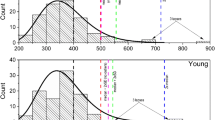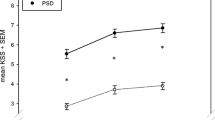Abstract
We have studied day-time vigilance in 31 patients (median age 49 years) with suspected sleep disorders using a new visual reaction time and performance test. The findings in the day-time vigilance test were compared with the number of desaturation events and movement arousals measured with a sensitive movement detector in the night-time.
In our statistical model the high number of desaturations correlated with a high dispersion in reaction-times. The squared multiple r was 0.465 in a model where the dispersion of reaction times was the dependent variable and the number of desaturations, duration of quiet sleep and the mode of oxygen saturation were independent variables. A high amount of body movements (movement arousals, duration less than 5 seconds) correlated with gradual deterioration in the performance test. The squared multiple r was 0.447 in a model where the regression coefficient of reaction times was the dependent variable and active sleep and number of body movements less than 5 seconds in duration were the independent variables. Frequent arousals in apnoeic patients are observed in hyper-excitable responders and are known to cause sleep deprivation and hypersomnia. Our findings in desaturating patients indicate that in those with a low chemoreceptor response to hypoxia the failure in day-time regulation of vigilance may differ from the failure associated with sleep-deprivation.
Similar content being viewed by others
References
Hoddes, Zarcone, Smythe, Phillips, Dement WC. Quantification of sleepiness: A new approach. Psychophysiology 1973; 4: 431–6.
Richardson, Carskadon et al. Excessive day-time sleepiness in man: Multiple sleep latency measurements in narcoleptic and control subjects. Electroenceph Clin Neurophysiol 1978; 45: 621–7.
Wilkinson RT. Methods for research on sleep deprivation and sleep function. Int Psychiatr Clin 1970; 7: 369–81.
Wilkinson RT, Houghton. Field test of arousal: A portable reaction timer with data storage. Hum Factors 1982; 24:487–93.
Lisper HO, Kjellberg A. Effects of 24-hour sleep deprivation on rate of decrement in a 10-minute auditory reaction time task. J Exp Psychol 1972; 96: 287–90.
Roth T et al. An alternative to the MSLT for determining sleepiness in narcolepsy and hypersomnia: Polygraphic score of sleepiness Sleep 1986; 9: 243–5.
Guilleminault C et al. Determinants of daytime sleepiness in obstructive sleep apnea. Chest 1988; 94: 32–7.
Sullivan CE et al. Sleep apnea—pathophysiology: Upper airway and control of Breathing. In: Guilleminault C, Partinen M, editors. Obstructive Sleep Apnea Syndrome: Clinical Research and Treatment. New York: Raven Press, 1990.
Roth T et al. Multiple naps and the evaluation of day-time sleepiness in patients with upper airway sleep apnea. Sleep 1980; 3: 425–39.
Guilleminault C, Partinen M. Day-time sleepiness in non-narcoleptic subjects: central nervous system hypersomnia and obstructive sleep apneic patients. In: Smiren S, Franceshi M, Ferini-Strambi L, editors. Sleep in Medical and Neuropsychiatric Disorders. Milano: Masson, 1988: 111–21.
Salmi T, Leinonen L. Automatic analysis of static charge sensitive bed records. Electroenceph Clin Neurophysiol 1986; 64: 84–7.
Salmi T, Telakivi T, Partinen M. Evaluation of automatic analysis of SCSB, airflow and oxygen saturation signals in patients with sleep related apneas. Chest 1989; 96: 255–61.
Dinges DF, Powell JW. Microcomputer analysis of performance on a portable, simple visual RT task during sustained operations. Behavior Research Methods, Instruments & Computers 1985; 17 (6): 652–5.
Kryger M, Roth T, Dement W, editors. Principles and Practice of Sleep Medicine. New York: Saunders, 1989.
Guilleminault et al. Insomnia with sleep apnea: A new syndrome. Science 1973; 181, 102: 856–8.
George CF et al. Sleep apnoea patients have more automobile accidents. Lancet 1987; 2: 447.
Sink J, Bliwise DL, Dement WC. Self-reported excessive day-time somnolence and impaired respiration in sleep. Chest 1986; 90: 177–80.
Author information
Authors and Affiliations
Rights and permissions
About this article
Cite this article
Jokinen, T., Salmi, T., Ylikoski, A. et al. Use of computerized visual performance test in assessing day-time vigilance in patients with sleep apneas and restless sleep. J Clin Monitor Comput 12, 225–230 (1995). https://doi.org/10.1007/BF01207203
Accepted:
Issue Date:
DOI: https://doi.org/10.1007/BF01207203




